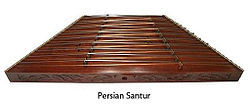Santur
- See Santoor for the Indian variant of the instrument.
 | |
| String | |
|---|---|
| Classification | Struck |
| Related instruments | |
| Hammered Dulcimer | |


The santur (also santūr, santour, santoor ) (Persian: سنتور) is a Persian hammered dulcimer[1] It is a trapezoid-shaped box often made of walnut or different exotic woods. The Persian classical santur has 72 strings.
Characteristics
The name santur was first referenced in ancient Persian poetry. To date there has never been verifiable evidence what this name actually means, it is just a name and the only meaning it has in the Persian language is this instrument. The oval-shaped Mezrabs (mallets) are feather-weight and are held between the thumb, index and middle fingers. A typical Persian santur has two sets of bridges, providing a range of approximately three octaves. The right-hand strings are made of brass or copper,[2] while the left-hand strings are made of steel.[3]
Two rows of 9 articles called "kharak" (total of 18 kharaks) divide the santur into three positions. Over each bridge crosses four strings spanning horizontally across the right and left side of the instrument. There are three sections of nine pitches: each for the bass, middle and higher octave called Poshte Kharak (behind the left bridges) comprising 27 notes all together. The top "F" note is repeated 2 times, creating a total of 25 separate tones in the Santur. The Persian santur is primarily tuned to a variety of different diatonic scales utilizing quarter tones, which are used in the twelve dastgahs (modes) of Persian classical music called the Radif.
Derivations
Similar forms of the santur have been present in neighboring cultures like India, Afghanistan, Pakistan, Armenia, Turkey, Iraq, China, and Greece. The Indian santoor is wider, more rectangular and has more strings. Its corresponding mallets are also held differently played with a different technique. The Chinese yangqin and the Greek santouri also derived from the santur. The eastern-European version of the santur called the cimballum which is much larger and chromatic is used as an accompanying instrument in gypsy music.[citation needed]
Notable Persian santur players
Iran
- Abol Hassan Saba
- Manoochehr Sadeghi
- Faramarz Payvar
- Parviz Meshkatian
- Majid Kiani[4]
- Mohammad Sadeq Khan[5]
- Ali Akbar Shahi[6]
- Hassan Khan[7]
- Hussein Malek[8]
- Habib Soma’i[9]
- Reza Varzandeh[10]
- Reza Shafieian[11]
- Mansur Sarami[12]
- Masoud Shaari[13]
- Mohammad Santour Khan[14]
- Daryoush Safvat[15]
- Jalal Akhbari[16]
- Kourosh Zolani
- Arfa Atrai[17]
- Azar Hashemi[18]
- Susan Aslani[19]
- Manijeh Ali Pour[20]
Santur players from other cultures
Greece
(Greek Santoori)
India (see Indian santoor)
Iraq
Japan
Santur makers
Nazemi produced the world's best santurs. He wasn't a craftsman, but he orchestrated the production of the best santurs made in Iran during the 1950s and 1960s. He used a master craftsman named Misour Levon died at the age of 91 in Glendale, California January 10, 2010.
Ali Bahmani made santurs that sound as good as Nazemi's. He took his craft to higher level, creating a machine press and created many advanced technology wood treatments, creative ideas that improved the longevity and quality of his santurs. Bahmani died in September 2011, in an accident in Tehran, Iran. He was only 35 years old and left behind a wife and a son.[citation needed]
Santurs from around the world
Versions of the santur or hammered dulcimer are used throughout the world. In Eastern Europe, a larger descendant of the hammered dulcimer called the cimbalom is played and has been used by a number of classical composers, including Zoltán Kodály, Igor Stravinsky and Pierre Boulez, and more recently, in a different musical context, by Blue Man Group. The khim is the name of both the Thai and the Khmer hammered dulcimer. The Chinese yangqin is a type of hammered dulcimer that originated in Persia. The santur and santoor are found in the Middle East and India, respectively.
|
|
See also
References
- ^ "Santur is a Persian hammered dulcimer". Art Max Academy.
- ^ "Bass strings made of Brass or Copper". Art Max Academy.
- ^ "Different kinds of Steel exist". Art Max Academy.
- ^ Kiani, Majid. "Master of the Santur". Santur Master, Teacher & Performer.
- ^ Khan, Mohammad Sadeq. "One of the oldest Santur Masters". Master of the Santur.
- ^ Shahi, Ali Akbar. "Santur master". Old school santur player.
- ^ Khan, Hassan. "Santur Master". Old school Santur Master.
- ^ Malek, Hussein. "Santur master". Old School Santur Master.
- ^ Somai, Habib. "santur master". Old school Santur master.
- ^ Varzandeh, Reza. "Santur Master". Very Unique Style of Playing.
- ^ Shafieian, Reza. "Saba's Student". Santur Master.
- ^ Sarami, Mansur. "Santur Master". Old School Santur player.
- ^ Shaari, Masoud. "Santur Master". Old School Santur Master.
- ^ Khan, Mohammad Santour. "Oldest Santur Master that we have proof of". Master of the Santur.
{{cite web}}: Missing or empty|url=(help) - ^ Safvat, Daryoush. "Santur Master". Old school Santur master.
- ^ Akhbari, Jalal. "Old School Santur Master". Master of the Santur.
- ^ Arfa, Atrai. "Santur Player". Santur Soloist.
- ^ Hashemi, Azar. "Female Santur Player". Santur Soloist.
- ^ Aslani, Susan. "Female Santur Player". Santur Soloist.
- ^ Ali Pour, Manijeh. "Female Santur Player". Old School Santur Player.
- ^ Tani, Dr. Masato. "Japanese Santur Player". Ethnomusicology.
- ^ "Santurs from different cultures". Wikipedia.
Further reading
Heydarian, P. (2005). "The Persian music and the santur instrument" (PDF). Proceedings of Sixth International Conference on Music Information Retrieval, London, UK. Vol. 11. pp. 524–527. {{cite conference}}: Unknown parameter |booktitle= ignored (|book-title= suggested) (help); Unknown parameter |coauthors= ignored (|author= suggested) (help)

